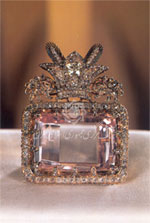 The famous Darya-i-Nur or Sea of light is the largest pink diamond of the world and takes the first place among the diamonds in the National Treasury of Iran. This famous diamond along with its mate, the Kooh-i-Nur, or Mountain of Light, perhaps due to similarity of names, has always come together in history, although there is no similarity in cut or color between these two diamonds. Both of these stones were in the possession of Nadir Shah. After his death, Ahmad Shah Durrani took Kooh-i-Nur ti Afghanistan. After Ahmad Shah, it passed on to Shah Shuja, and after the defeat of Shah Shuja by Ranjit Singh the Lion of the Punjab, it passed into his possession. Later East India Company obtained it and presented it as a gift to Queen Victoria. It is presently in the Queen Mother’s Crown in England.
The famous Darya-i-Nur or Sea of light is the largest pink diamond of the world and takes the first place among the diamonds in the National Treasury of Iran. This famous diamond along with its mate, the Kooh-i-Nur, or Mountain of Light, perhaps due to similarity of names, has always come together in history, although there is no similarity in cut or color between these two diamonds. Both of these stones were in the possession of Nadir Shah. After his death, Ahmad Shah Durrani took Kooh-i-Nur ti Afghanistan. After Ahmad Shah, it passed on to Shah Shuja, and after the defeat of Shah Shuja by Ranjit Singh the Lion of the Punjab, it passed into his possession. Later East India Company obtained it and presented it as a gift to Queen Victoria. It is presently in the Queen Mother’s Crown in England.The Darya-i-Nur diamond was inherited by Shahrokh Mirza, the grandson of Nadir Shah. It then came into the possession of Amir Alam Khan Khozeimeh, and later, Lotfaio Khan Zand. When Lotfali Khan Zand was defeated by Agha Mohammad Khan Qajar, this diamond came into the treasury of the Qajar kings. Nasser-ed-din Shah believed that this diamond was one of the gems decorating the crown of Cyrus (558 to 529 BC), and was very fond of it. He wore it as an armband, aigrette or as a brooch. The maintenance of Darya-i-Nur was a high, special honor bestowed upon high-ranking personages. Darye-i-Nur later entered the Treasury of National Jewels of Iran. The weight of Darya-i-Nur is approximately 182 carats, and its colors are pale pink --- one of the rare colors for diamonds. The frame is set with 457 diamonds and 4 rubies. In 1965, during the research by a Canadian team on the National Jewels, an interesting point was revealed. The famous French jeweler and traveler, Tavernier, mentions in his book, that he has seen a large, pink diamond weighing 242 carats, in the East, in 1642. he named it “Diamonda Grande Table”. The color and size of this diamond caught the attention of this Canadian team, and they believed that Darya-i-Nur and Nur-ol-Eyn were originally one stone, that later got spilt into two stones, part becoming the Darya-i-Nur, and part the 60 carat Nur-ol-Eyn that is presently mounted in Tiara No. 2 displayed in Case 26.
No comments:
Post a Comment